ARBE1301: Legal System and Contract Assignment Report
VerifiedAdded on 2022/11/25
|13
|3867
|338
Report
AI Summary
This assignment report provides an overview of the Australian legal system, focusing on the role of common law and its relationship with enacted legislation. It delves into the structure of the legal system, including the various courts and their hierarchies, with an emphasis on the High Court of Australia and the doctrine of precedent. The report explains key legal principles like stare decisis and ratio decidendi, illustrating them with relevant case law. Furthermore, it addresses contract law essentials, including agreement, consideration, and contractual intentions. The report also highlights the legal issues concerning contract formation and liability in construction projects, such as design defects and late completion. This analysis is designed to provide a comprehensive understanding of the legal framework governing the construction industry in Australia, covering both the procedural and substantive aspects of law.
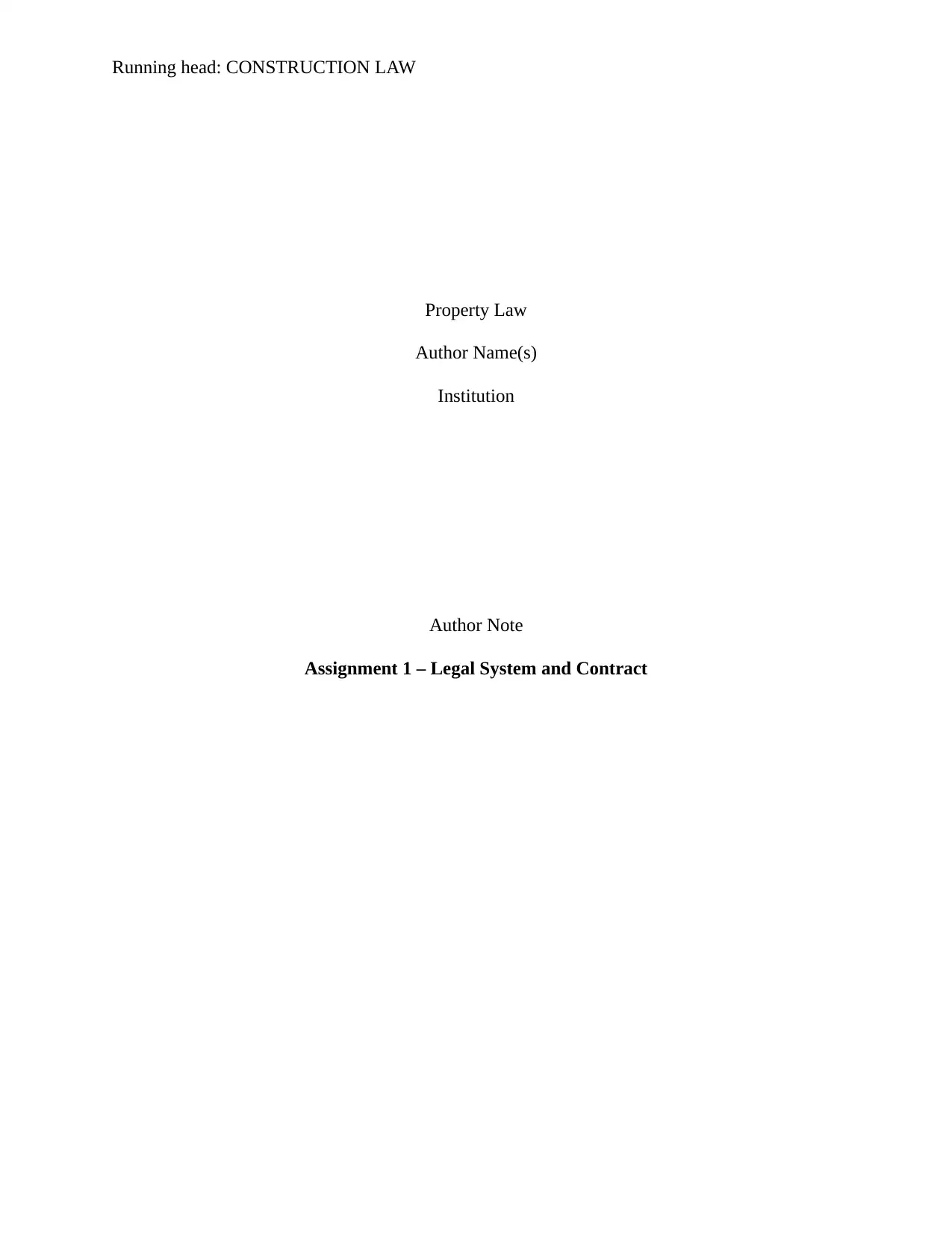
Running head: CONSTRUCTION LAW
Property Law
Author Name(s)
Institution
Author Note
Assignment 1 – Legal System and Contract
Property Law
Author Name(s)
Institution
Author Note
Assignment 1 – Legal System and Contract
Paraphrase This Document
Need a fresh take? Get an instant paraphrase of this document with our AI Paraphraser
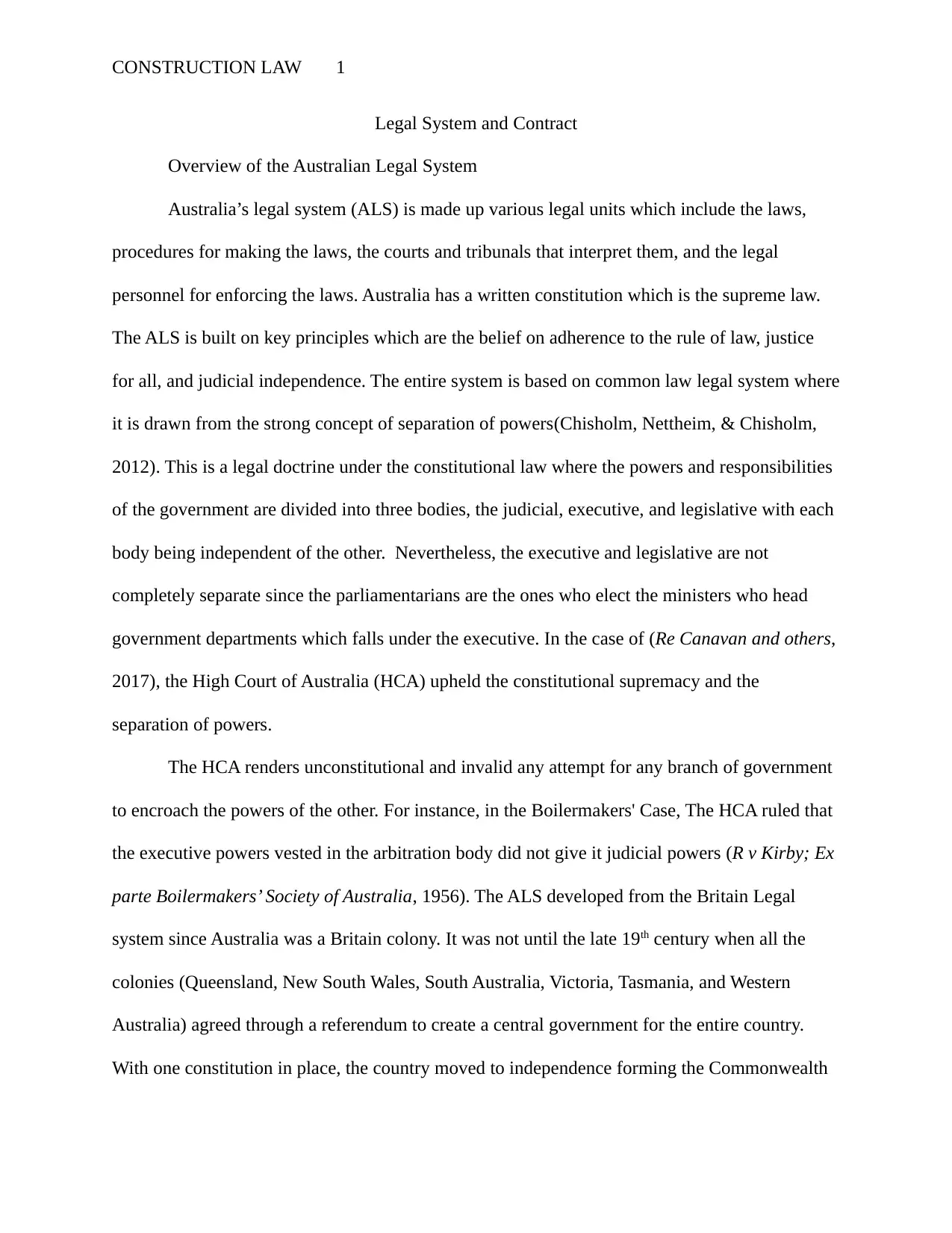
CONSTRUCTION LAW 1
Legal System and Contract
Overview of the Australian Legal System
Australia’s legal system (ALS) is made up various legal units which include the laws,
procedures for making the laws, the courts and tribunals that interpret them, and the legal
personnel for enforcing the laws. Australia has a written constitution which is the supreme law.
The ALS is built on key principles which are the belief on adherence to the rule of law, justice
for all, and judicial independence. The entire system is based on common law legal system where
it is drawn from the strong concept of separation of powers(Chisholm, Nettheim, & Chisholm,
2012). This is a legal doctrine under the constitutional law where the powers and responsibilities
of the government are divided into three bodies, the judicial, executive, and legislative with each
body being independent of the other. Nevertheless, the executive and legislative are not
completely separate since the parliamentarians are the ones who elect the ministers who head
government departments which falls under the executive. In the case of (Re Canavan and others,
2017), the High Court of Australia (HCA) upheld the constitutional supremacy and the
separation of powers.
The HCA renders unconstitutional and invalid any attempt for any branch of government
to encroach the powers of the other. For instance, in the Boilermakers' Case, The HCA ruled that
the executive powers vested in the arbitration body did not give it judicial powers (R v Kirby; Ex
parte Boilermakers’ Society of Australia, 1956). The ALS developed from the Britain Legal
system since Australia was a Britain colony. It was not until the late 19th century when all the
colonies (Queensland, New South Wales, South Australia, Victoria, Tasmania, and Western
Australia) agreed through a referendum to create a central government for the entire country.
With one constitution in place, the country moved to independence forming the Commonwealth
Legal System and Contract
Overview of the Australian Legal System
Australia’s legal system (ALS) is made up various legal units which include the laws,
procedures for making the laws, the courts and tribunals that interpret them, and the legal
personnel for enforcing the laws. Australia has a written constitution which is the supreme law.
The ALS is built on key principles which are the belief on adherence to the rule of law, justice
for all, and judicial independence. The entire system is based on common law legal system where
it is drawn from the strong concept of separation of powers(Chisholm, Nettheim, & Chisholm,
2012). This is a legal doctrine under the constitutional law where the powers and responsibilities
of the government are divided into three bodies, the judicial, executive, and legislative with each
body being independent of the other. Nevertheless, the executive and legislative are not
completely separate since the parliamentarians are the ones who elect the ministers who head
government departments which falls under the executive. In the case of (Re Canavan and others,
2017), the High Court of Australia (HCA) upheld the constitutional supremacy and the
separation of powers.
The HCA renders unconstitutional and invalid any attempt for any branch of government
to encroach the powers of the other. For instance, in the Boilermakers' Case, The HCA ruled that
the executive powers vested in the arbitration body did not give it judicial powers (R v Kirby; Ex
parte Boilermakers’ Society of Australia, 1956). The ALS developed from the Britain Legal
system since Australia was a Britain colony. It was not until the late 19th century when all the
colonies (Queensland, New South Wales, South Australia, Victoria, Tasmania, and Western
Australia) agreed through a referendum to create a central government for the entire country.
With one constitution in place, the country moved to independence forming the Commonwealth
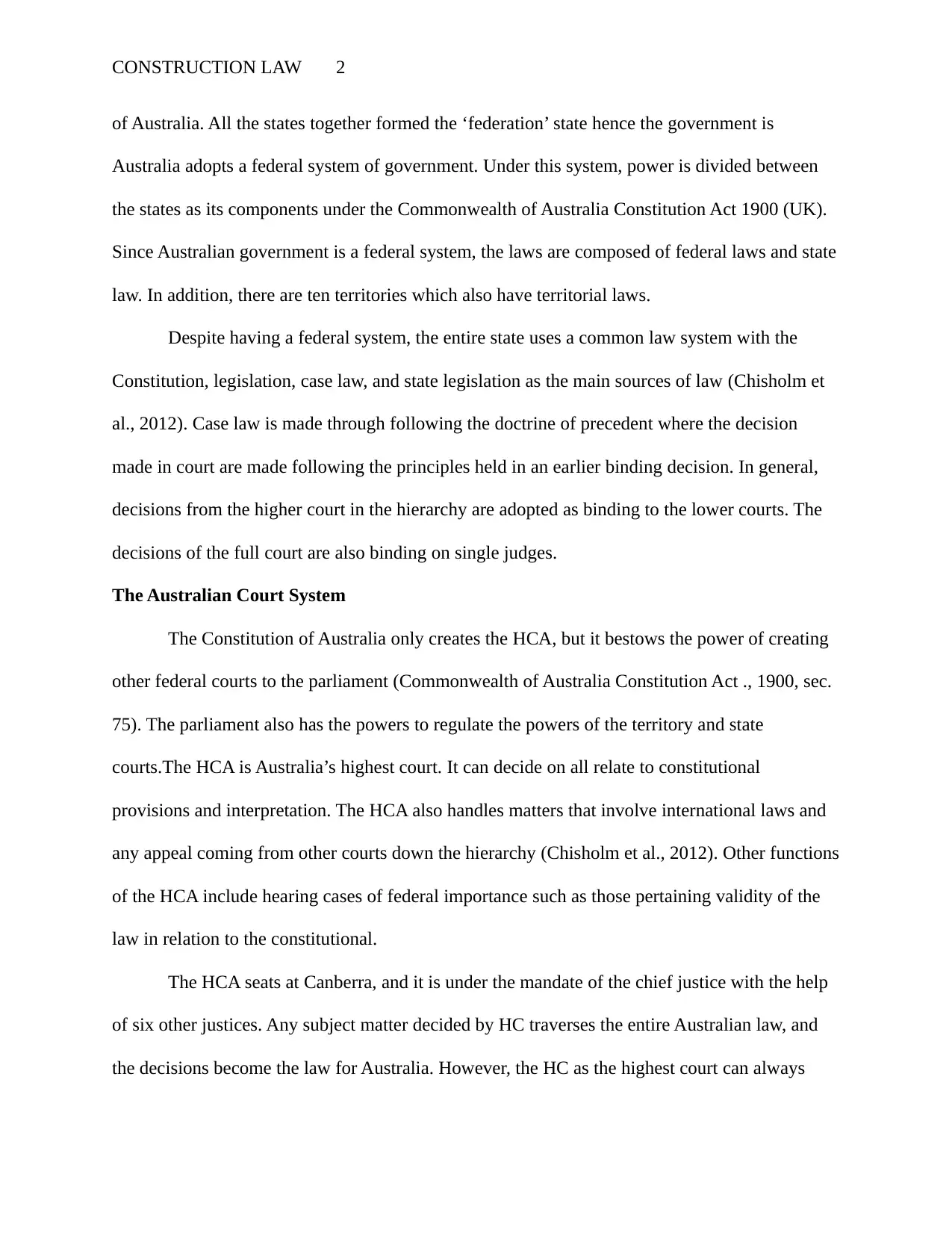
CONSTRUCTION LAW 2
of Australia. All the states together formed the ‘federation’ state hence the government is
Australia adopts a federal system of government. Under this system, power is divided between
the states as its components under the Commonwealth of Australia Constitution Act 1900 (UK).
Since Australian government is a federal system, the laws are composed of federal laws and state
law. In addition, there are ten territories which also have territorial laws.
Despite having a federal system, the entire state uses a common law system with the
Constitution, legislation, case law, and state legislation as the main sources of law (Chisholm et
al., 2012). Case law is made through following the doctrine of precedent where the decision
made in court are made following the principles held in an earlier binding decision. In general,
decisions from the higher court in the hierarchy are adopted as binding to the lower courts. The
decisions of the full court are also binding on single judges.
The Australian Court System
The Constitution of Australia only creates the HCA, but it bestows the power of creating
other federal courts to the parliament (Commonwealth of Australia Constitution Act ., 1900, sec.
75). The parliament also has the powers to regulate the powers of the territory and state
courts.The HCA is Australia’s highest court. It can decide on all relate to constitutional
provisions and interpretation. The HCA also handles matters that involve international laws and
any appeal coming from other courts down the hierarchy (Chisholm et al., 2012). Other functions
of the HCA include hearing cases of federal importance such as those pertaining validity of the
law in relation to the constitutional.
The HCA seats at Canberra, and it is under the mandate of the chief justice with the help
of six other justices. Any subject matter decided by HC traverses the entire Australian law, and
the decisions become the law for Australia. However, the HC as the highest court can always
of Australia. All the states together formed the ‘federation’ state hence the government is
Australia adopts a federal system of government. Under this system, power is divided between
the states as its components under the Commonwealth of Australia Constitution Act 1900 (UK).
Since Australian government is a federal system, the laws are composed of federal laws and state
law. In addition, there are ten territories which also have territorial laws.
Despite having a federal system, the entire state uses a common law system with the
Constitution, legislation, case law, and state legislation as the main sources of law (Chisholm et
al., 2012). Case law is made through following the doctrine of precedent where the decision
made in court are made following the principles held in an earlier binding decision. In general,
decisions from the higher court in the hierarchy are adopted as binding to the lower courts. The
decisions of the full court are also binding on single judges.
The Australian Court System
The Constitution of Australia only creates the HCA, but it bestows the power of creating
other federal courts to the parliament (Commonwealth of Australia Constitution Act ., 1900, sec.
75). The parliament also has the powers to regulate the powers of the territory and state
courts.The HCA is Australia’s highest court. It can decide on all relate to constitutional
provisions and interpretation. The HCA also handles matters that involve international laws and
any appeal coming from other courts down the hierarchy (Chisholm et al., 2012). Other functions
of the HCA include hearing cases of federal importance such as those pertaining validity of the
law in relation to the constitutional.
The HCA seats at Canberra, and it is under the mandate of the chief justice with the help
of six other justices. Any subject matter decided by HC traverses the entire Australian law, and
the decisions become the law for Australia. However, the HC as the highest court can always
⊘ This is a preview!⊘
Do you want full access?
Subscribe today to unlock all pages.

Trusted by 1+ million students worldwide
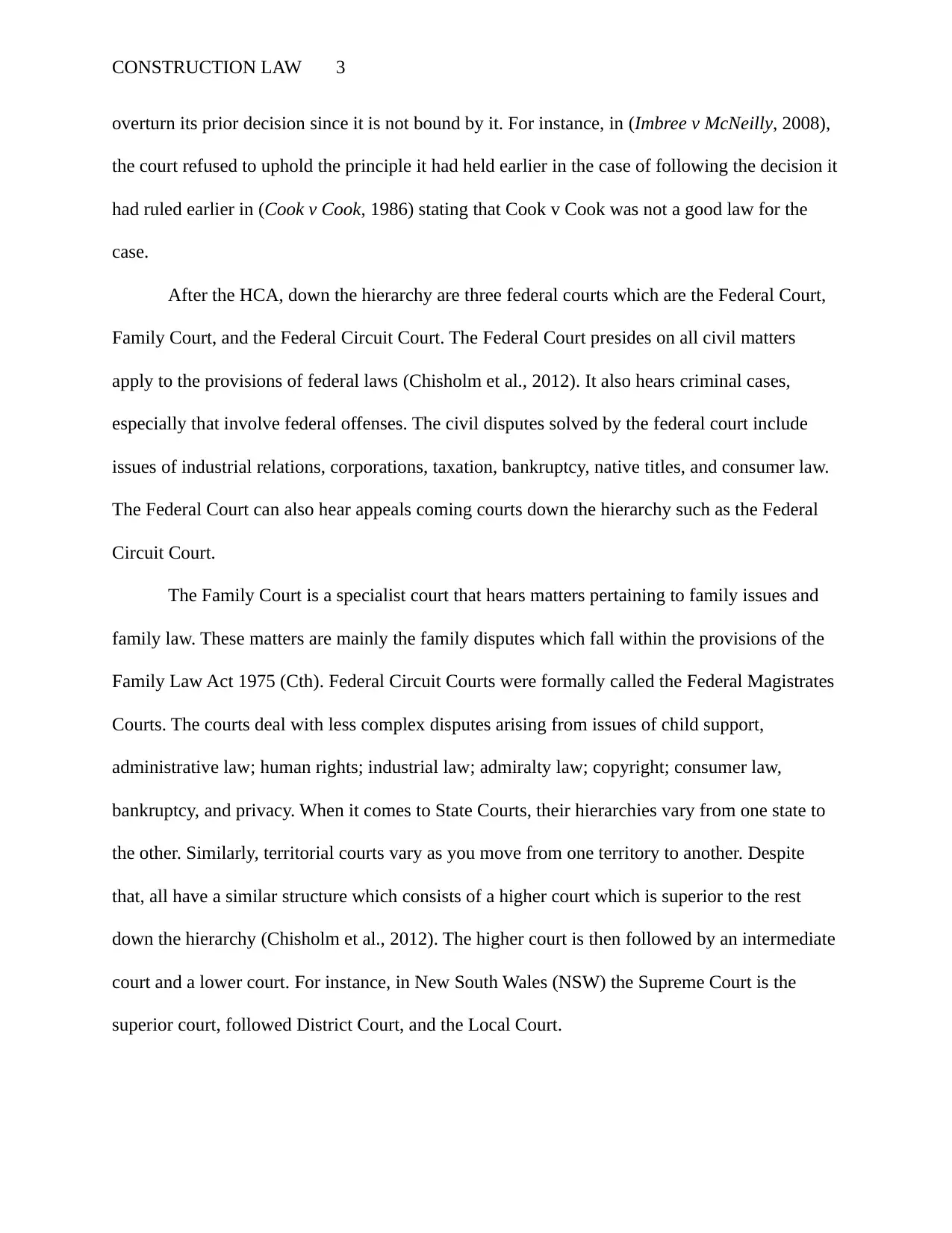
CONSTRUCTION LAW 3
overturn its prior decision since it is not bound by it. For instance, in (Imbree v McNeilly, 2008),
the court refused to uphold the principle it had held earlier in the case of following the decision it
had ruled earlier in (Cook v Cook, 1986) stating that Cook v Cook was not a good law for the
case.
After the HCA, down the hierarchy are three federal courts which are the Federal Court,
Family Court, and the Federal Circuit Court. The Federal Court presides on all civil matters
apply to the provisions of federal laws (Chisholm et al., 2012). It also hears criminal cases,
especially that involve federal offenses. The civil disputes solved by the federal court include
issues of industrial relations, corporations, taxation, bankruptcy, native titles, and consumer law.
The Federal Court can also hear appeals coming courts down the hierarchy such as the Federal
Circuit Court.
The Family Court is a specialist court that hears matters pertaining to family issues and
family law. These matters are mainly the family disputes which fall within the provisions of the
Family Law Act 1975 (Cth). Federal Circuit Courts were formally called the Federal Magistrates
Courts. The courts deal with less complex disputes arising from issues of child support,
administrative law; human rights; industrial law; admiralty law; copyright; consumer law,
bankruptcy, and privacy. When it comes to State Courts, their hierarchies vary from one state to
the other. Similarly, territorial courts vary as you move from one territory to another. Despite
that, all have a similar structure which consists of a higher court which is superior to the rest
down the hierarchy (Chisholm et al., 2012). The higher court is then followed by an intermediate
court and a lower court. For instance, in New South Wales (NSW) the Supreme Court is the
superior court, followed District Court, and the Local Court.
overturn its prior decision since it is not bound by it. For instance, in (Imbree v McNeilly, 2008),
the court refused to uphold the principle it had held earlier in the case of following the decision it
had ruled earlier in (Cook v Cook, 1986) stating that Cook v Cook was not a good law for the
case.
After the HCA, down the hierarchy are three federal courts which are the Federal Court,
Family Court, and the Federal Circuit Court. The Federal Court presides on all civil matters
apply to the provisions of federal laws (Chisholm et al., 2012). It also hears criminal cases,
especially that involve federal offenses. The civil disputes solved by the federal court include
issues of industrial relations, corporations, taxation, bankruptcy, native titles, and consumer law.
The Federal Court can also hear appeals coming courts down the hierarchy such as the Federal
Circuit Court.
The Family Court is a specialist court that hears matters pertaining to family issues and
family law. These matters are mainly the family disputes which fall within the provisions of the
Family Law Act 1975 (Cth). Federal Circuit Courts were formally called the Federal Magistrates
Courts. The courts deal with less complex disputes arising from issues of child support,
administrative law; human rights; industrial law; admiralty law; copyright; consumer law,
bankruptcy, and privacy. When it comes to State Courts, their hierarchies vary from one state to
the other. Similarly, territorial courts vary as you move from one territory to another. Despite
that, all have a similar structure which consists of a higher court which is superior to the rest
down the hierarchy (Chisholm et al., 2012). The higher court is then followed by an intermediate
court and a lower court. For instance, in New South Wales (NSW) the Supreme Court is the
superior court, followed District Court, and the Local Court.
Paraphrase This Document
Need a fresh take? Get an instant paraphrase of this document with our AI Paraphraser
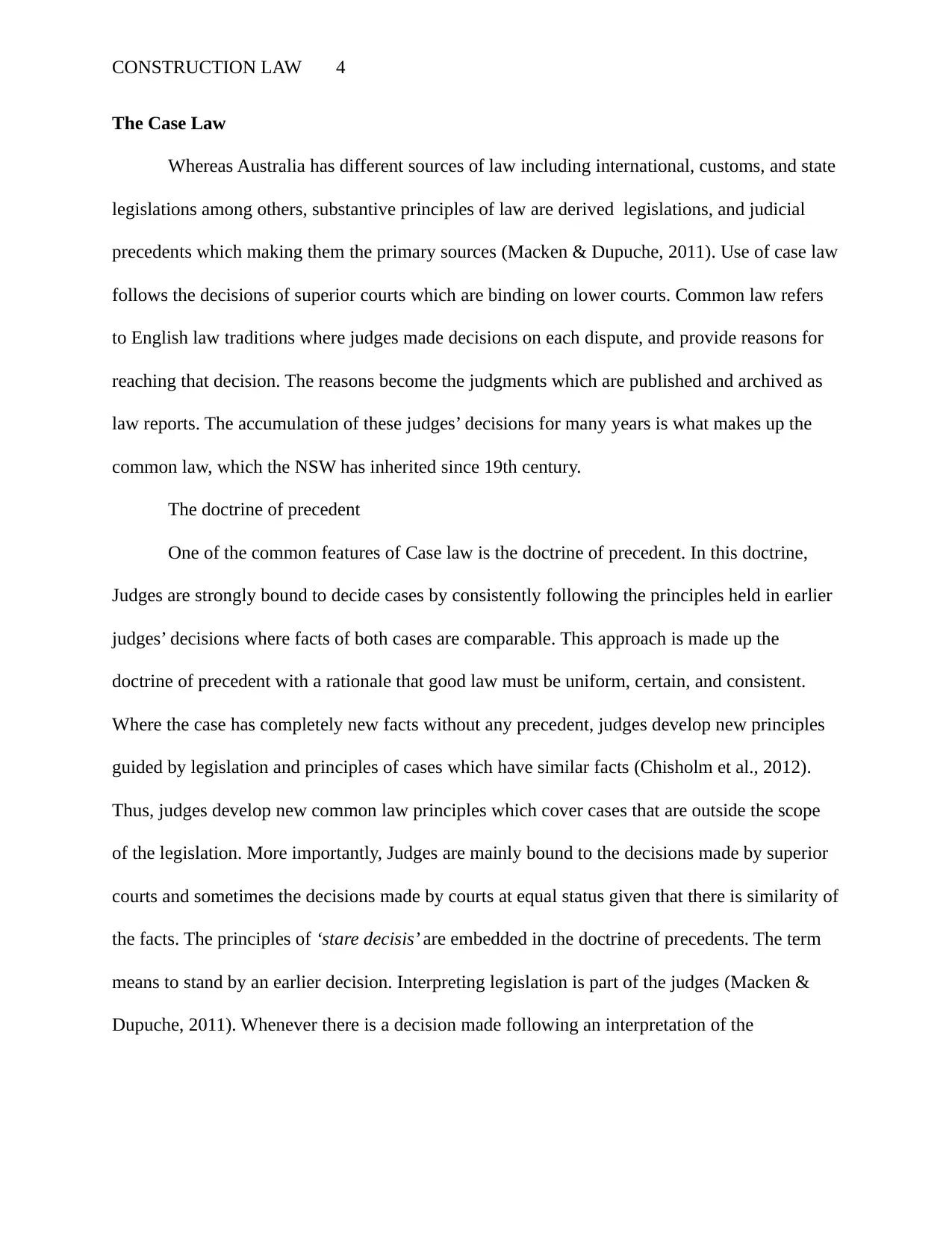
CONSTRUCTION LAW 4
The Case Law
Whereas Australia has different sources of law including international, customs, and state
legislations among others, substantive principles of law are derived legislations, and judicial
precedents which making them the primary sources (Macken & Dupuche, 2011). Use of case law
follows the decisions of superior courts which are binding on lower courts. Common law refers
to English law traditions where judges made decisions on each dispute, and provide reasons for
reaching that decision. The reasons become the judgments which are published and archived as
law reports. The accumulation of these judges’ decisions for many years is what makes up the
common law, which the NSW has inherited since 19th century.
The doctrine of precedent
One of the common features of Case law is the doctrine of precedent. In this doctrine,
Judges are strongly bound to decide cases by consistently following the principles held in earlier
judges’ decisions where facts of both cases are comparable. This approach is made up the
doctrine of precedent with a rationale that good law must be uniform, certain, and consistent.
Where the case has completely new facts without any precedent, judges develop new principles
guided by legislation and principles of cases which have similar facts (Chisholm et al., 2012).
Thus, judges develop new common law principles which cover cases that are outside the scope
of the legislation. More importantly, Judges are mainly bound to the decisions made by superior
courts and sometimes the decisions made by courts at equal status given that there is similarity of
the facts. The principles of ‘stare decisis’ are embedded in the doctrine of precedents. The term
means to stand by an earlier decision. Interpreting legislation is part of the judges (Macken &
Dupuche, 2011). Whenever there is a decision made following an interpretation of the
The Case Law
Whereas Australia has different sources of law including international, customs, and state
legislations among others, substantive principles of law are derived legislations, and judicial
precedents which making them the primary sources (Macken & Dupuche, 2011). Use of case law
follows the decisions of superior courts which are binding on lower courts. Common law refers
to English law traditions where judges made decisions on each dispute, and provide reasons for
reaching that decision. The reasons become the judgments which are published and archived as
law reports. The accumulation of these judges’ decisions for many years is what makes up the
common law, which the NSW has inherited since 19th century.
The doctrine of precedent
One of the common features of Case law is the doctrine of precedent. In this doctrine,
Judges are strongly bound to decide cases by consistently following the principles held in earlier
judges’ decisions where facts of both cases are comparable. This approach is made up the
doctrine of precedent with a rationale that good law must be uniform, certain, and consistent.
Where the case has completely new facts without any precedent, judges develop new principles
guided by legislation and principles of cases which have similar facts (Chisholm et al., 2012).
Thus, judges develop new common law principles which cover cases that are outside the scope
of the legislation. More importantly, Judges are mainly bound to the decisions made by superior
courts and sometimes the decisions made by courts at equal status given that there is similarity of
the facts. The principles of ‘stare decisis’ are embedded in the doctrine of precedents. The term
means to stand by an earlier decision. Interpreting legislation is part of the judges (Macken &
Dupuche, 2011). Whenever there is a decision made following an interpretation of the
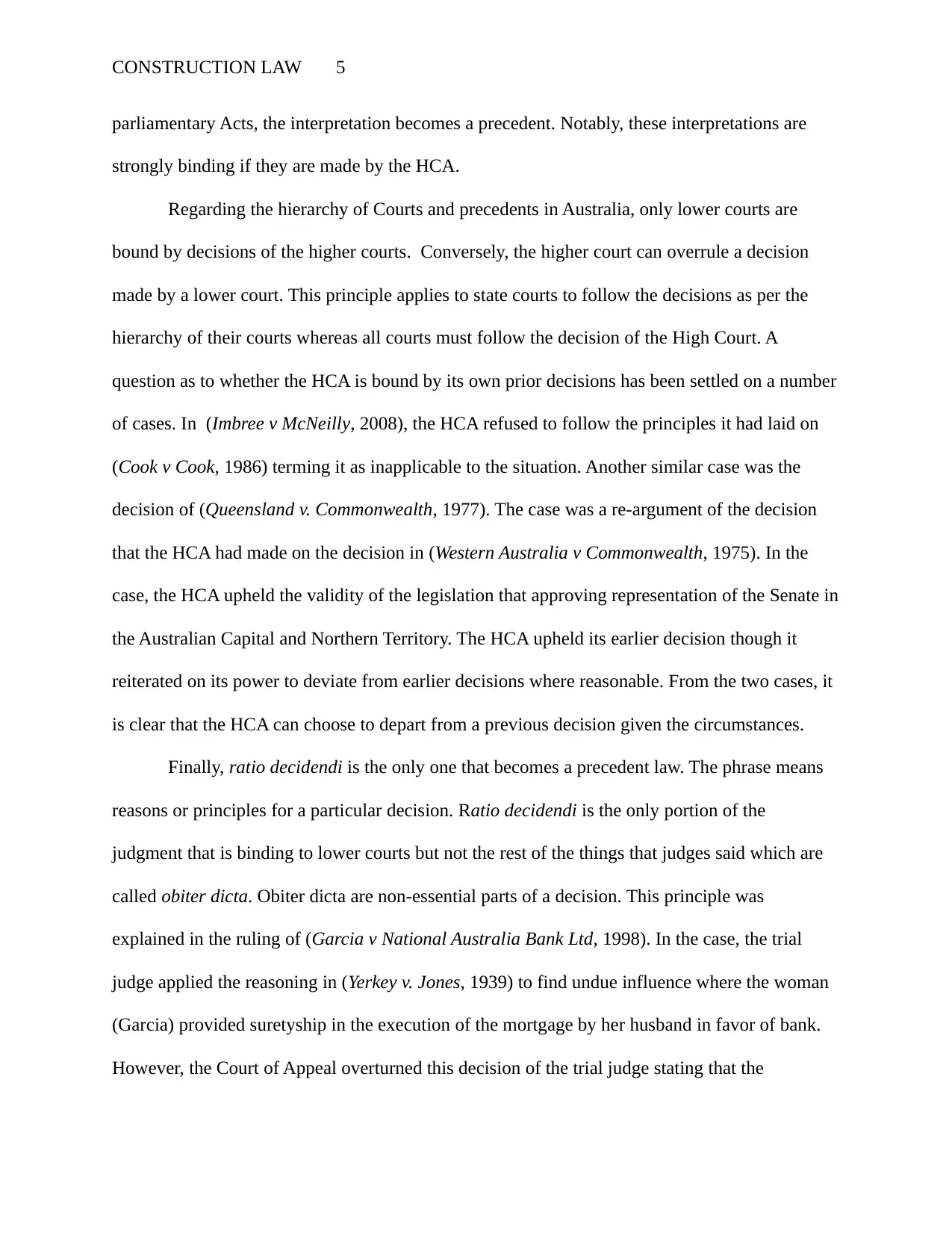
CONSTRUCTION LAW 5
parliamentary Acts, the interpretation becomes a precedent. Notably, these interpretations are
strongly binding if they are made by the HCA.
Regarding the hierarchy of Courts and precedents in Australia, only lower courts are
bound by decisions of the higher courts. Conversely, the higher court can overrule a decision
made by a lower court. This principle applies to state courts to follow the decisions as per the
hierarchy of their courts whereas all courts must follow the decision of the High Court. A
question as to whether the HCA is bound by its own prior decisions has been settled on a number
of cases. In (Imbree v McNeilly, 2008), the HCA refused to follow the principles it had laid on
(Cook v Cook, 1986) terming it as inapplicable to the situation. Another similar case was the
decision of (Queensland v. Commonwealth, 1977). The case was a re-argument of the decision
that the HCA had made on the decision in (Western Australia v Commonwealth, 1975). In the
case, the HCA upheld the validity of the legislation that approving representation of the Senate in
the Australian Capital and Northern Territory. The HCA upheld its earlier decision though it
reiterated on its power to deviate from earlier decisions where reasonable. From the two cases, it
is clear that the HCA can choose to depart from a previous decision given the circumstances.
Finally, ratio decidendi is the only one that becomes a precedent law. The phrase means
reasons or principles for a particular decision. Ratio decidendi is the only portion of the
judgment that is binding to lower courts but not the rest of the things that judges said which are
called obiter dicta. Obiter dicta are non-essential parts of a decision. This principle was
explained in the ruling of (Garcia v National Australia Bank Ltd, 1998). In the case, the trial
judge applied the reasoning in (Yerkey v. Jones, 1939) to find undue influence where the woman
(Garcia) provided suretyship in the execution of the mortgage by her husband in favor of bank.
However, the Court of Appeal overturned this decision of the trial judge stating that the
parliamentary Acts, the interpretation becomes a precedent. Notably, these interpretations are
strongly binding if they are made by the HCA.
Regarding the hierarchy of Courts and precedents in Australia, only lower courts are
bound by decisions of the higher courts. Conversely, the higher court can overrule a decision
made by a lower court. This principle applies to state courts to follow the decisions as per the
hierarchy of their courts whereas all courts must follow the decision of the High Court. A
question as to whether the HCA is bound by its own prior decisions has been settled on a number
of cases. In (Imbree v McNeilly, 2008), the HCA refused to follow the principles it had laid on
(Cook v Cook, 1986) terming it as inapplicable to the situation. Another similar case was the
decision of (Queensland v. Commonwealth, 1977). The case was a re-argument of the decision
that the HCA had made on the decision in (Western Australia v Commonwealth, 1975). In the
case, the HCA upheld the validity of the legislation that approving representation of the Senate in
the Australian Capital and Northern Territory. The HCA upheld its earlier decision though it
reiterated on its power to deviate from earlier decisions where reasonable. From the two cases, it
is clear that the HCA can choose to depart from a previous decision given the circumstances.
Finally, ratio decidendi is the only one that becomes a precedent law. The phrase means
reasons or principles for a particular decision. Ratio decidendi is the only portion of the
judgment that is binding to lower courts but not the rest of the things that judges said which are
called obiter dicta. Obiter dicta are non-essential parts of a decision. This principle was
explained in the ruling of (Garcia v National Australia Bank Ltd, 1998). In the case, the trial
judge applied the reasoning in (Yerkey v. Jones, 1939) to find undue influence where the woman
(Garcia) provided suretyship in the execution of the mortgage by her husband in favor of bank.
However, the Court of Appeal overturned this decision of the trial judge stating that the
⊘ This is a preview!⊘
Do you want full access?
Subscribe today to unlock all pages.

Trusted by 1+ million students worldwide
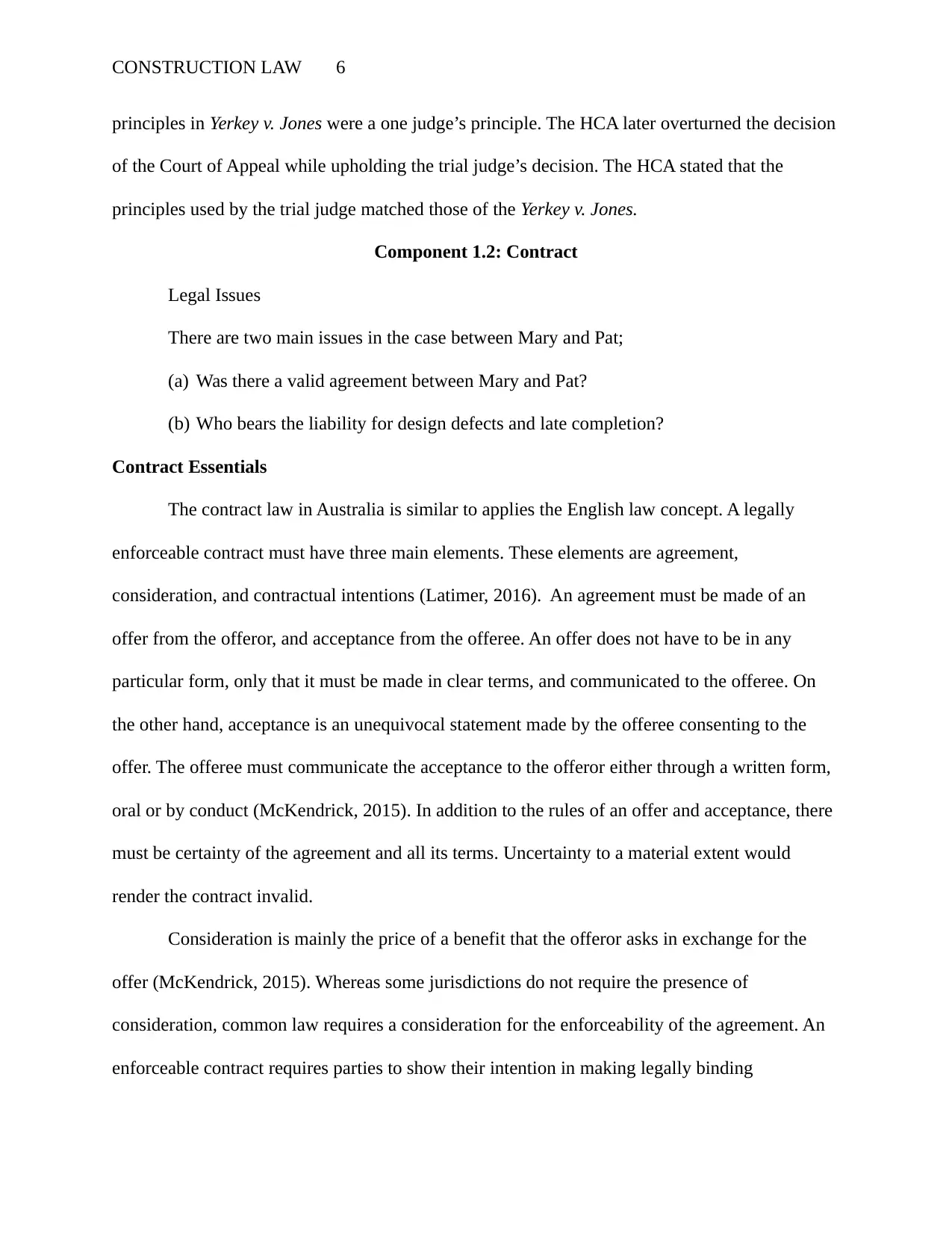
CONSTRUCTION LAW 6
principles in Yerkey v. Jones were a one judge’s principle. The HCA later overturned the decision
of the Court of Appeal while upholding the trial judge’s decision. The HCA stated that the
principles used by the trial judge matched those of the Yerkey v. Jones.
Component 1.2: Contract
Legal Issues
There are two main issues in the case between Mary and Pat;
(a) Was there a valid agreement between Mary and Pat?
(b) Who bears the liability for design defects and late completion?
Contract Essentials
The contract law in Australia is similar to applies the English law concept. A legally
enforceable contract must have three main elements. These elements are agreement,
consideration, and contractual intentions (Latimer, 2016). An agreement must be made of an
offer from the offeror, and acceptance from the offeree. An offer does not have to be in any
particular form, only that it must be made in clear terms, and communicated to the offeree. On
the other hand, acceptance is an unequivocal statement made by the offeree consenting to the
offer. The offeree must communicate the acceptance to the offeror either through a written form,
oral or by conduct (McKendrick, 2015). In addition to the rules of an offer and acceptance, there
must be certainty of the agreement and all its terms. Uncertainty to a material extent would
render the contract invalid.
Consideration is mainly the price of a benefit that the offeror asks in exchange for the
offer (McKendrick, 2015). Whereas some jurisdictions do not require the presence of
consideration, common law requires a consideration for the enforceability of the agreement. An
enforceable contract requires parties to show their intention in making legally binding
principles in Yerkey v. Jones were a one judge’s principle. The HCA later overturned the decision
of the Court of Appeal while upholding the trial judge’s decision. The HCA stated that the
principles used by the trial judge matched those of the Yerkey v. Jones.
Component 1.2: Contract
Legal Issues
There are two main issues in the case between Mary and Pat;
(a) Was there a valid agreement between Mary and Pat?
(b) Who bears the liability for design defects and late completion?
Contract Essentials
The contract law in Australia is similar to applies the English law concept. A legally
enforceable contract must have three main elements. These elements are agreement,
consideration, and contractual intentions (Latimer, 2016). An agreement must be made of an
offer from the offeror, and acceptance from the offeree. An offer does not have to be in any
particular form, only that it must be made in clear terms, and communicated to the offeree. On
the other hand, acceptance is an unequivocal statement made by the offeree consenting to the
offer. The offeree must communicate the acceptance to the offeror either through a written form,
oral or by conduct (McKendrick, 2015). In addition to the rules of an offer and acceptance, there
must be certainty of the agreement and all its terms. Uncertainty to a material extent would
render the contract invalid.
Consideration is mainly the price of a benefit that the offeror asks in exchange for the
offer (McKendrick, 2015). Whereas some jurisdictions do not require the presence of
consideration, common law requires a consideration for the enforceability of the agreement. An
enforceable contract requires parties to show their intention in making legally binding
Paraphrase This Document
Need a fresh take? Get an instant paraphrase of this document with our AI Paraphraser
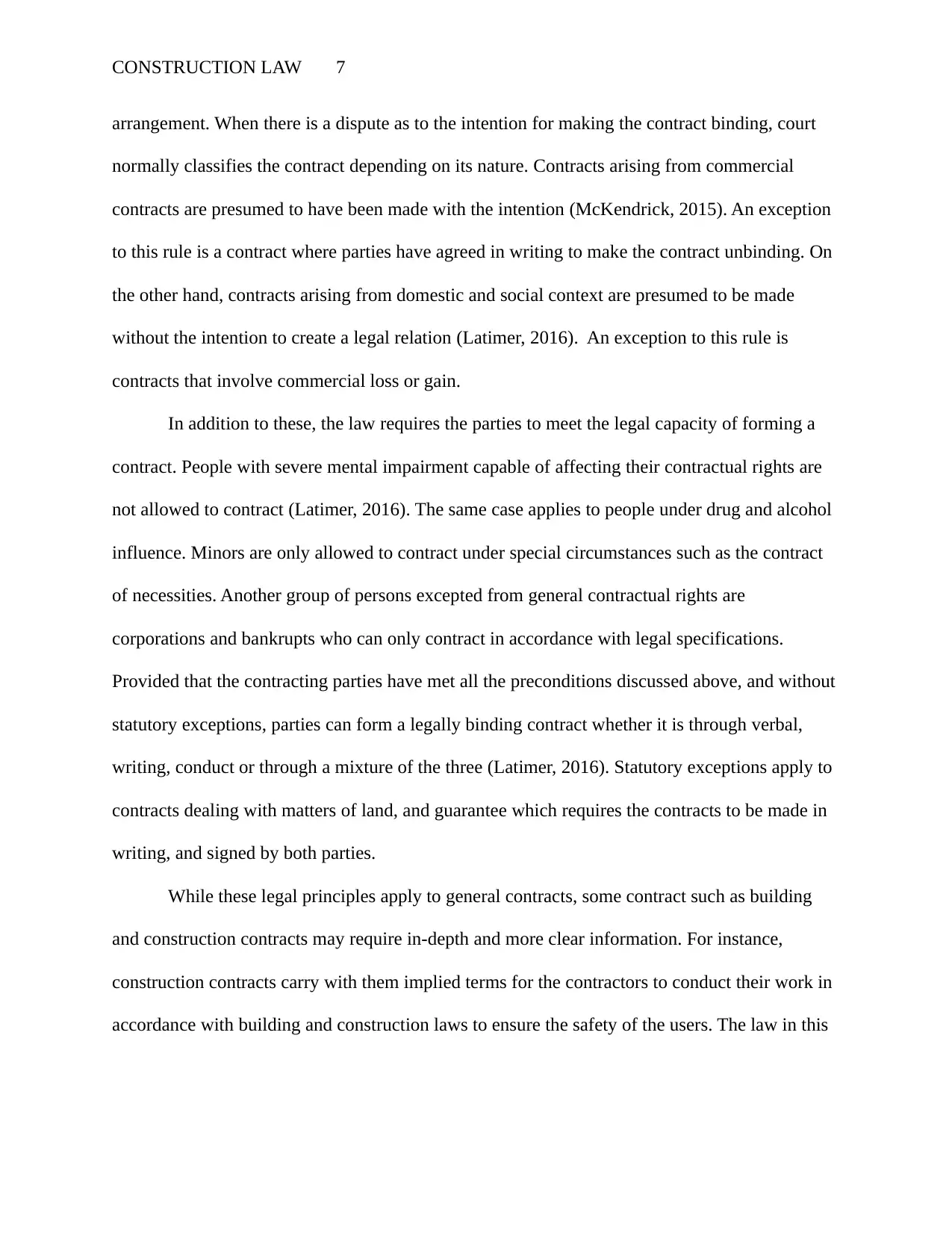
CONSTRUCTION LAW 7
arrangement. When there is a dispute as to the intention for making the contract binding, court
normally classifies the contract depending on its nature. Contracts arising from commercial
contracts are presumed to have been made with the intention (McKendrick, 2015). An exception
to this rule is a contract where parties have agreed in writing to make the contract unbinding. On
the other hand, contracts arising from domestic and social context are presumed to be made
without the intention to create a legal relation (Latimer, 2016). An exception to this rule is
contracts that involve commercial loss or gain.
In addition to these, the law requires the parties to meet the legal capacity of forming a
contract. People with severe mental impairment capable of affecting their contractual rights are
not allowed to contract (Latimer, 2016). The same case applies to people under drug and alcohol
influence. Minors are only allowed to contract under special circumstances such as the contract
of necessities. Another group of persons excepted from general contractual rights are
corporations and bankrupts who can only contract in accordance with legal specifications.
Provided that the contracting parties have met all the preconditions discussed above, and without
statutory exceptions, parties can form a legally binding contract whether it is through verbal,
writing, conduct or through a mixture of the three (Latimer, 2016). Statutory exceptions apply to
contracts dealing with matters of land, and guarantee which requires the contracts to be made in
writing, and signed by both parties.
While these legal principles apply to general contracts, some contract such as building
and construction contracts may require in-depth and more clear information. For instance,
construction contracts carry with them implied terms for the contractors to conduct their work in
accordance with building and construction laws to ensure the safety of the users. The law in this
arrangement. When there is a dispute as to the intention for making the contract binding, court
normally classifies the contract depending on its nature. Contracts arising from commercial
contracts are presumed to have been made with the intention (McKendrick, 2015). An exception
to this rule is a contract where parties have agreed in writing to make the contract unbinding. On
the other hand, contracts arising from domestic and social context are presumed to be made
without the intention to create a legal relation (Latimer, 2016). An exception to this rule is
contracts that involve commercial loss or gain.
In addition to these, the law requires the parties to meet the legal capacity of forming a
contract. People with severe mental impairment capable of affecting their contractual rights are
not allowed to contract (Latimer, 2016). The same case applies to people under drug and alcohol
influence. Minors are only allowed to contract under special circumstances such as the contract
of necessities. Another group of persons excepted from general contractual rights are
corporations and bankrupts who can only contract in accordance with legal specifications.
Provided that the contracting parties have met all the preconditions discussed above, and without
statutory exceptions, parties can form a legally binding contract whether it is through verbal,
writing, conduct or through a mixture of the three (Latimer, 2016). Statutory exceptions apply to
contracts dealing with matters of land, and guarantee which requires the contracts to be made in
writing, and signed by both parties.
While these legal principles apply to general contracts, some contract such as building
and construction contracts may require in-depth and more clear information. For instance,
construction contracts carry with them implied terms for the contractors to conduct their work in
accordance with building and construction laws to ensure the safety of the users. The law in this
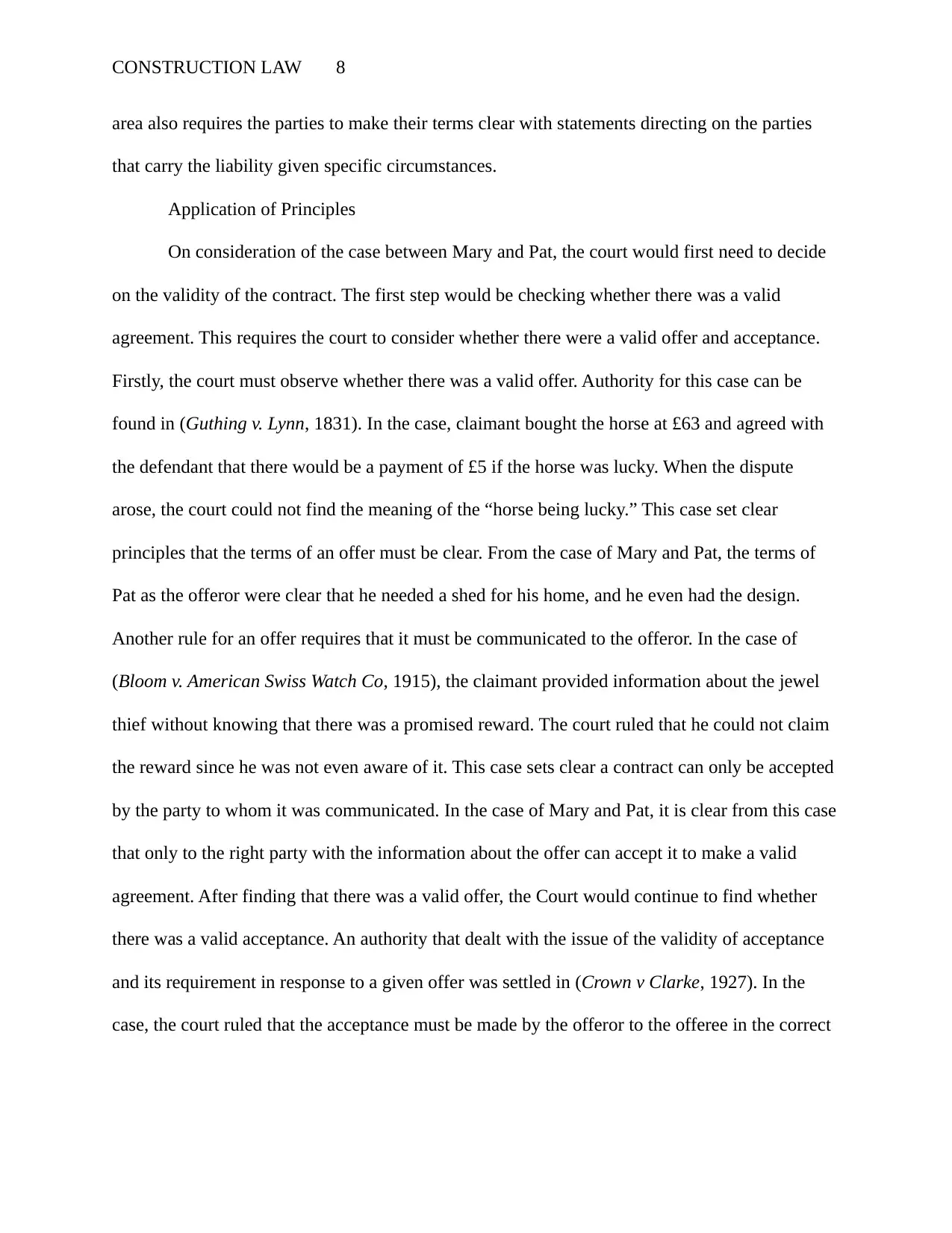
CONSTRUCTION LAW 8
area also requires the parties to make their terms clear with statements directing on the parties
that carry the liability given specific circumstances.
Application of Principles
On consideration of the case between Mary and Pat, the court would first need to decide
on the validity of the contract. The first step would be checking whether there was a valid
agreement. This requires the court to consider whether there were a valid offer and acceptance.
Firstly, the court must observe whether there was a valid offer. Authority for this case can be
found in (Guthing v. Lynn, 1831). In the case, claimant bought the horse at £63 and agreed with
the defendant that there would be a payment of £5 if the horse was lucky. When the dispute
arose, the court could not find the meaning of the “horse being lucky.” This case set clear
principles that the terms of an offer must be clear. From the case of Mary and Pat, the terms of
Pat as the offeror were clear that he needed a shed for his home, and he even had the design.
Another rule for an offer requires that it must be communicated to the offeror. In the case of
(Bloom v. American Swiss Watch Co, 1915), the claimant provided information about the jewel
thief without knowing that there was a promised reward. The court ruled that he could not claim
the reward since he was not even aware of it. This case sets clear a contract can only be accepted
by the party to whom it was communicated. In the case of Mary and Pat, it is clear from this case
that only to the right party with the information about the offer can accept it to make a valid
agreement. After finding that there was a valid offer, the Court would continue to find whether
there was a valid acceptance. An authority that dealt with the issue of the validity of acceptance
and its requirement in response to a given offer was settled in (Crown v Clarke, 1927). In the
case, the court ruled that the acceptance must be made by the offeror to the offeree in the correct
area also requires the parties to make their terms clear with statements directing on the parties
that carry the liability given specific circumstances.
Application of Principles
On consideration of the case between Mary and Pat, the court would first need to decide
on the validity of the contract. The first step would be checking whether there was a valid
agreement. This requires the court to consider whether there were a valid offer and acceptance.
Firstly, the court must observe whether there was a valid offer. Authority for this case can be
found in (Guthing v. Lynn, 1831). In the case, claimant bought the horse at £63 and agreed with
the defendant that there would be a payment of £5 if the horse was lucky. When the dispute
arose, the court could not find the meaning of the “horse being lucky.” This case set clear
principles that the terms of an offer must be clear. From the case of Mary and Pat, the terms of
Pat as the offeror were clear that he needed a shed for his home, and he even had the design.
Another rule for an offer requires that it must be communicated to the offeror. In the case of
(Bloom v. American Swiss Watch Co, 1915), the claimant provided information about the jewel
thief without knowing that there was a promised reward. The court ruled that he could not claim
the reward since he was not even aware of it. This case sets clear a contract can only be accepted
by the party to whom it was communicated. In the case of Mary and Pat, it is clear from this case
that only to the right party with the information about the offer can accept it to make a valid
agreement. After finding that there was a valid offer, the Court would continue to find whether
there was a valid acceptance. An authority that dealt with the issue of the validity of acceptance
and its requirement in response to a given offer was settled in (Crown v Clarke, 1927). In the
case, the court ruled that the acceptance must be made by the offeror to the offeree in the correct
⊘ This is a preview!⊘
Do you want full access?
Subscribe today to unlock all pages.

Trusted by 1+ million students worldwide
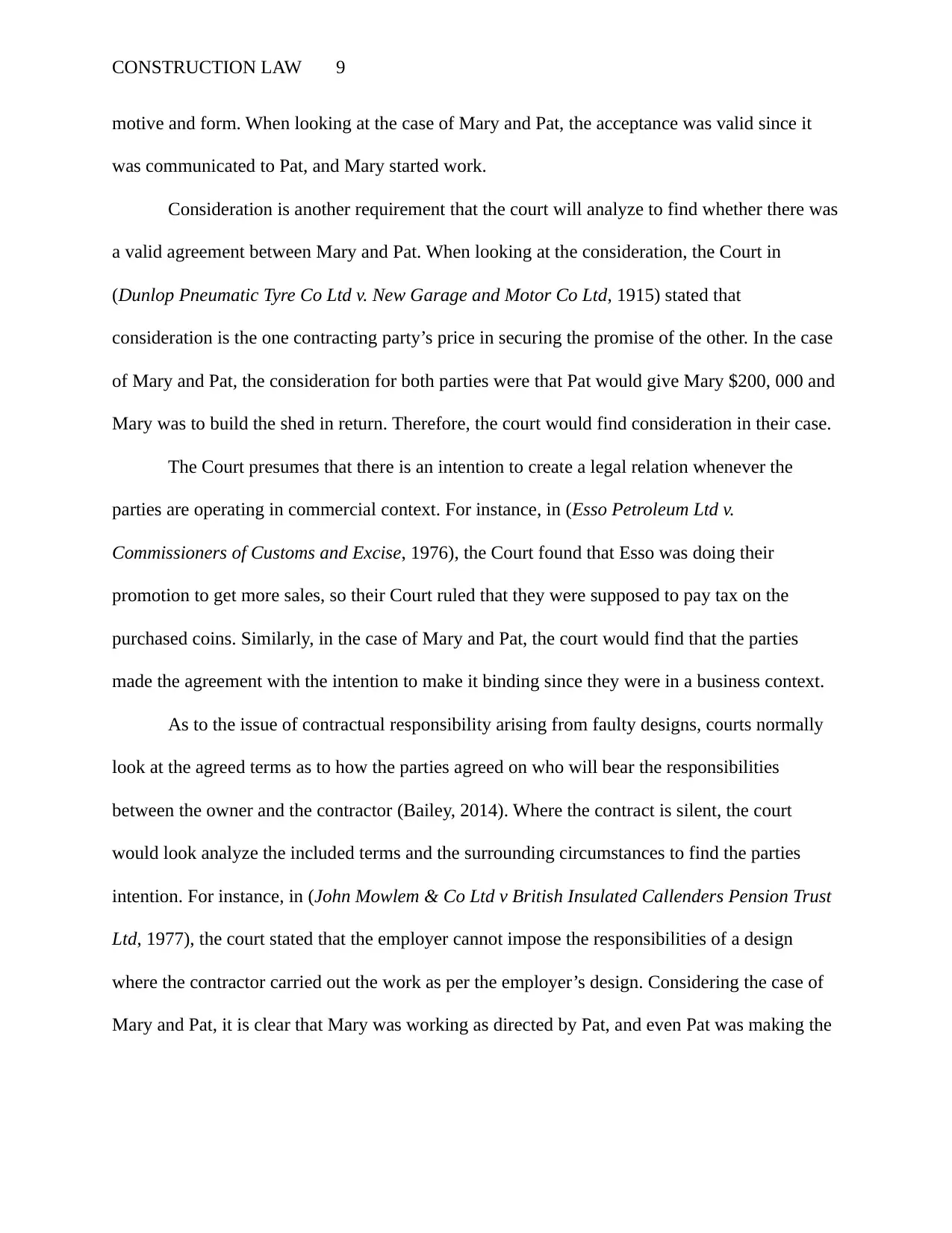
CONSTRUCTION LAW 9
motive and form. When looking at the case of Mary and Pat, the acceptance was valid since it
was communicated to Pat, and Mary started work.
Consideration is another requirement that the court will analyze to find whether there was
a valid agreement between Mary and Pat. When looking at the consideration, the Court in
(Dunlop Pneumatic Tyre Co Ltd v. New Garage and Motor Co Ltd, 1915) stated that
consideration is the one contracting party’s price in securing the promise of the other. In the case
of Mary and Pat, the consideration for both parties were that Pat would give Mary $200, 000 and
Mary was to build the shed in return. Therefore, the court would find consideration in their case.
The Court presumes that there is an intention to create a legal relation whenever the
parties are operating in commercial context. For instance, in (Esso Petroleum Ltd v.
Commissioners of Customs and Excise, 1976), the Court found that Esso was doing their
promotion to get more sales, so their Court ruled that they were supposed to pay tax on the
purchased coins. Similarly, in the case of Mary and Pat, the court would find that the parties
made the agreement with the intention to make it binding since they were in a business context.
As to the issue of contractual responsibility arising from faulty designs, courts normally
look at the agreed terms as to how the parties agreed on who will bear the responsibilities
between the owner and the contractor (Bailey, 2014). Where the contract is silent, the court
would look analyze the included terms and the surrounding circumstances to find the parties
intention. For instance, in (John Mowlem & Co Ltd v British Insulated Callenders Pension Trust
Ltd, 1977), the court stated that the employer cannot impose the responsibilities of a design
where the contractor carried out the work as per the employer’s design. Considering the case of
Mary and Pat, it is clear that Mary was working as directed by Pat, and even Pat was making the
motive and form. When looking at the case of Mary and Pat, the acceptance was valid since it
was communicated to Pat, and Mary started work.
Consideration is another requirement that the court will analyze to find whether there was
a valid agreement between Mary and Pat. When looking at the consideration, the Court in
(Dunlop Pneumatic Tyre Co Ltd v. New Garage and Motor Co Ltd, 1915) stated that
consideration is the one contracting party’s price in securing the promise of the other. In the case
of Mary and Pat, the consideration for both parties were that Pat would give Mary $200, 000 and
Mary was to build the shed in return. Therefore, the court would find consideration in their case.
The Court presumes that there is an intention to create a legal relation whenever the
parties are operating in commercial context. For instance, in (Esso Petroleum Ltd v.
Commissioners of Customs and Excise, 1976), the Court found that Esso was doing their
promotion to get more sales, so their Court ruled that they were supposed to pay tax on the
purchased coins. Similarly, in the case of Mary and Pat, the court would find that the parties
made the agreement with the intention to make it binding since they were in a business context.
As to the issue of contractual responsibility arising from faulty designs, courts normally
look at the agreed terms as to how the parties agreed on who will bear the responsibilities
between the owner and the contractor (Bailey, 2014). Where the contract is silent, the court
would look analyze the included terms and the surrounding circumstances to find the parties
intention. For instance, in (John Mowlem & Co Ltd v British Insulated Callenders Pension Trust
Ltd, 1977), the court stated that the employer cannot impose the responsibilities of a design
where the contractor carried out the work as per the employer’s design. Considering the case of
Mary and Pat, it is clear that Mary was working as directed by Pat, and even Pat was making the
Paraphrase This Document
Need a fresh take? Get an instant paraphrase of this document with our AI Paraphraser
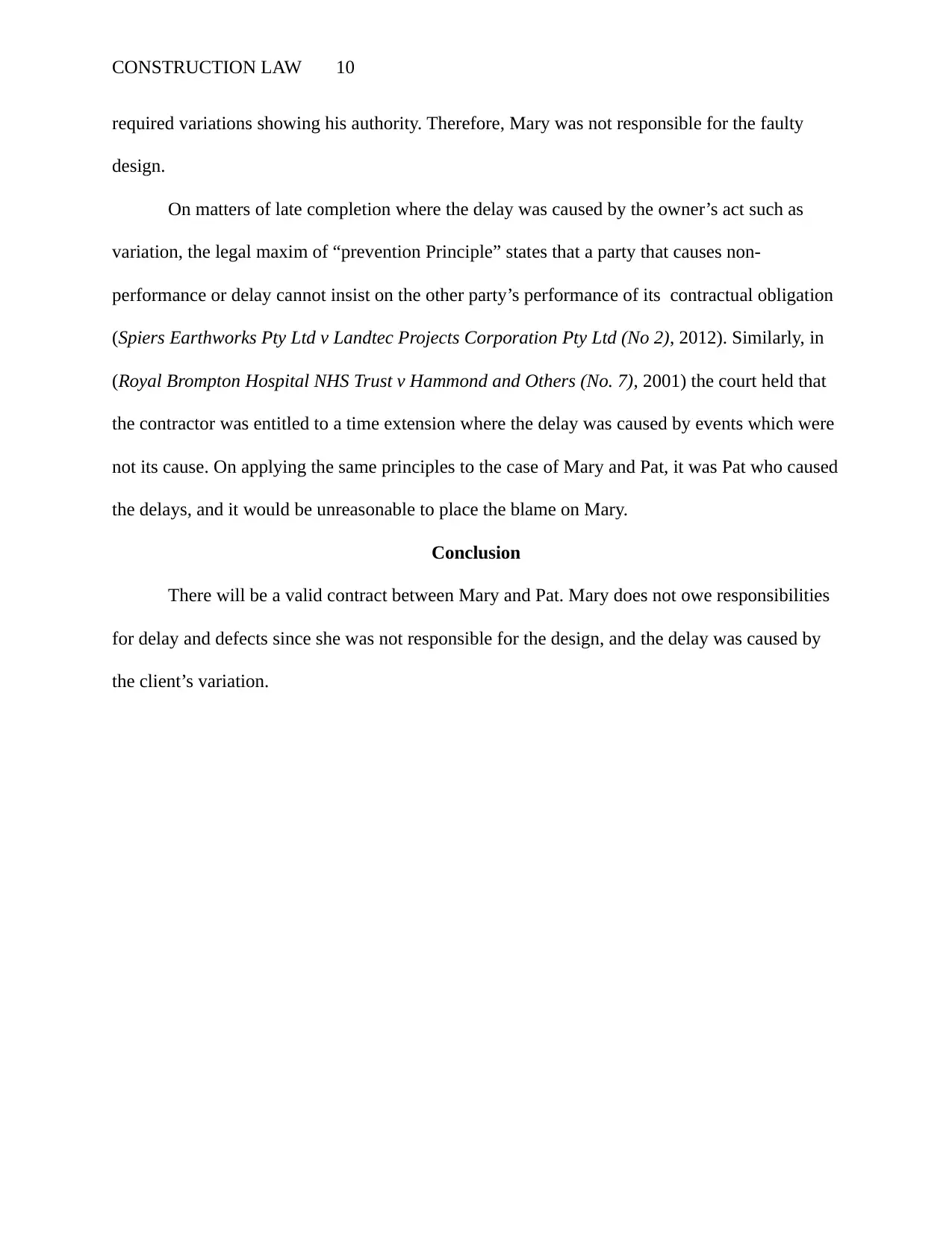
CONSTRUCTION LAW 10
required variations showing his authority. Therefore, Mary was not responsible for the faulty
design.
On matters of late completion where the delay was caused by the owner’s act such as
variation, the legal maxim of “prevention Principle” states that a party that causes non-
performance or delay cannot insist on the other party’s performance of its contractual obligation
(Spiers Earthworks Pty Ltd v Landtec Projects Corporation Pty Ltd (No 2), 2012). Similarly, in
(Royal Brompton Hospital NHS Trust v Hammond and Others (No. 7), 2001) the court held that
the contractor was entitled to a time extension where the delay was caused by events which were
not its cause. On applying the same principles to the case of Mary and Pat, it was Pat who caused
the delays, and it would be unreasonable to place the blame on Mary.
Conclusion
There will be a valid contract between Mary and Pat. Mary does not owe responsibilities
for delay and defects since she was not responsible for the design, and the delay was caused by
the client’s variation.
required variations showing his authority. Therefore, Mary was not responsible for the faulty
design.
On matters of late completion where the delay was caused by the owner’s act such as
variation, the legal maxim of “prevention Principle” states that a party that causes non-
performance or delay cannot insist on the other party’s performance of its contractual obligation
(Spiers Earthworks Pty Ltd v Landtec Projects Corporation Pty Ltd (No 2), 2012). Similarly, in
(Royal Brompton Hospital NHS Trust v Hammond and Others (No. 7), 2001) the court held that
the contractor was entitled to a time extension where the delay was caused by events which were
not its cause. On applying the same principles to the case of Mary and Pat, it was Pat who caused
the delays, and it would be unreasonable to place the blame on Mary.
Conclusion
There will be a valid contract between Mary and Pat. Mary does not owe responsibilities
for delay and defects since she was not responsible for the design, and the delay was caused by
the client’s variation.
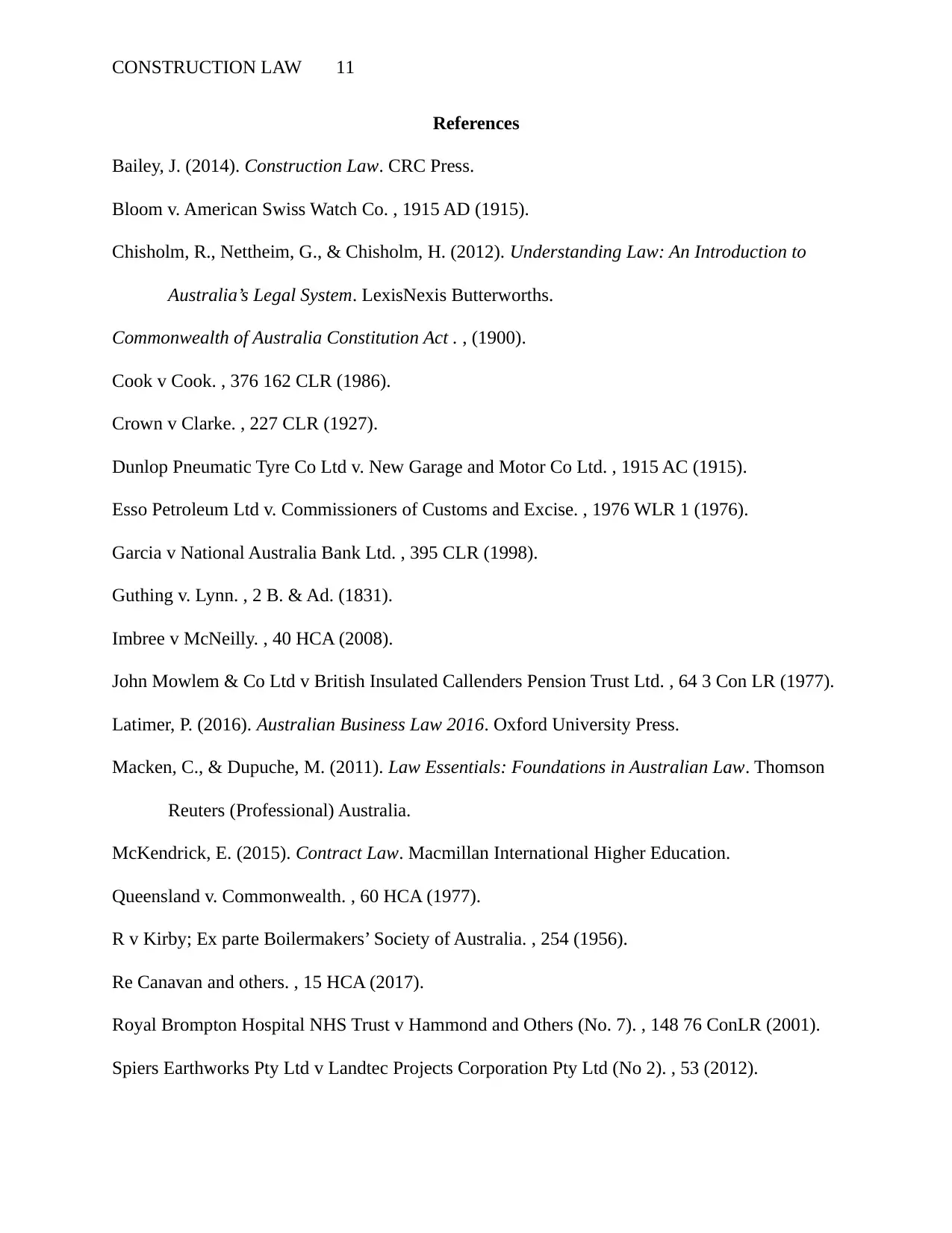
CONSTRUCTION LAW 11
References
Bailey, J. (2014). Construction Law. CRC Press.
Bloom v. American Swiss Watch Co. , 1915 AD (1915).
Chisholm, R., Nettheim, G., & Chisholm, H. (2012). Understanding Law: An Introduction to
Australia’s Legal System. LexisNexis Butterworths.
Commonwealth of Australia Constitution Act . , (1900).
Cook v Cook. , 376 162 CLR (1986).
Crown v Clarke. , 227 CLR (1927).
Dunlop Pneumatic Tyre Co Ltd v. New Garage and Motor Co Ltd. , 1915 AC (1915).
Esso Petroleum Ltd v. Commissioners of Customs and Excise. , 1976 WLR 1 (1976).
Garcia v National Australia Bank Ltd. , 395 CLR (1998).
Guthing v. Lynn. , 2 B. & Ad. (1831).
Imbree v McNeilly. , 40 HCA (2008).
John Mowlem & Co Ltd v British Insulated Callenders Pension Trust Ltd. , 64 3 Con LR (1977).
Latimer, P. (2016). Australian Business Law 2016. Oxford University Press.
Macken, C., & Dupuche, M. (2011). Law Essentials: Foundations in Australian Law. Thomson
Reuters (Professional) Australia.
McKendrick, E. (2015). Contract Law. Macmillan International Higher Education.
Queensland v. Commonwealth. , 60 HCA (1977).
R v Kirby; Ex parte Boilermakers’ Society of Australia. , 254 (1956).
Re Canavan and others. , 15 HCA (2017).
Royal Brompton Hospital NHS Trust v Hammond and Others (No. 7). , 148 76 ConLR (2001).
Spiers Earthworks Pty Ltd v Landtec Projects Corporation Pty Ltd (No 2). , 53 (2012).
References
Bailey, J. (2014). Construction Law. CRC Press.
Bloom v. American Swiss Watch Co. , 1915 AD (1915).
Chisholm, R., Nettheim, G., & Chisholm, H. (2012). Understanding Law: An Introduction to
Australia’s Legal System. LexisNexis Butterworths.
Commonwealth of Australia Constitution Act . , (1900).
Cook v Cook. , 376 162 CLR (1986).
Crown v Clarke. , 227 CLR (1927).
Dunlop Pneumatic Tyre Co Ltd v. New Garage and Motor Co Ltd. , 1915 AC (1915).
Esso Petroleum Ltd v. Commissioners of Customs and Excise. , 1976 WLR 1 (1976).
Garcia v National Australia Bank Ltd. , 395 CLR (1998).
Guthing v. Lynn. , 2 B. & Ad. (1831).
Imbree v McNeilly. , 40 HCA (2008).
John Mowlem & Co Ltd v British Insulated Callenders Pension Trust Ltd. , 64 3 Con LR (1977).
Latimer, P. (2016). Australian Business Law 2016. Oxford University Press.
Macken, C., & Dupuche, M. (2011). Law Essentials: Foundations in Australian Law. Thomson
Reuters (Professional) Australia.
McKendrick, E. (2015). Contract Law. Macmillan International Higher Education.
Queensland v. Commonwealth. , 60 HCA (1977).
R v Kirby; Ex parte Boilermakers’ Society of Australia. , 254 (1956).
Re Canavan and others. , 15 HCA (2017).
Royal Brompton Hospital NHS Trust v Hammond and Others (No. 7). , 148 76 ConLR (2001).
Spiers Earthworks Pty Ltd v Landtec Projects Corporation Pty Ltd (No 2). , 53 (2012).
⊘ This is a preview!⊘
Do you want full access?
Subscribe today to unlock all pages.

Trusted by 1+ million students worldwide
1 out of 13
Related Documents
Your All-in-One AI-Powered Toolkit for Academic Success.
+13062052269
info@desklib.com
Available 24*7 on WhatsApp / Email
![[object Object]](/_next/static/media/star-bottom.7253800d.svg)
Unlock your academic potential
Copyright © 2020–2025 A2Z Services. All Rights Reserved. Developed and managed by ZUCOL.





